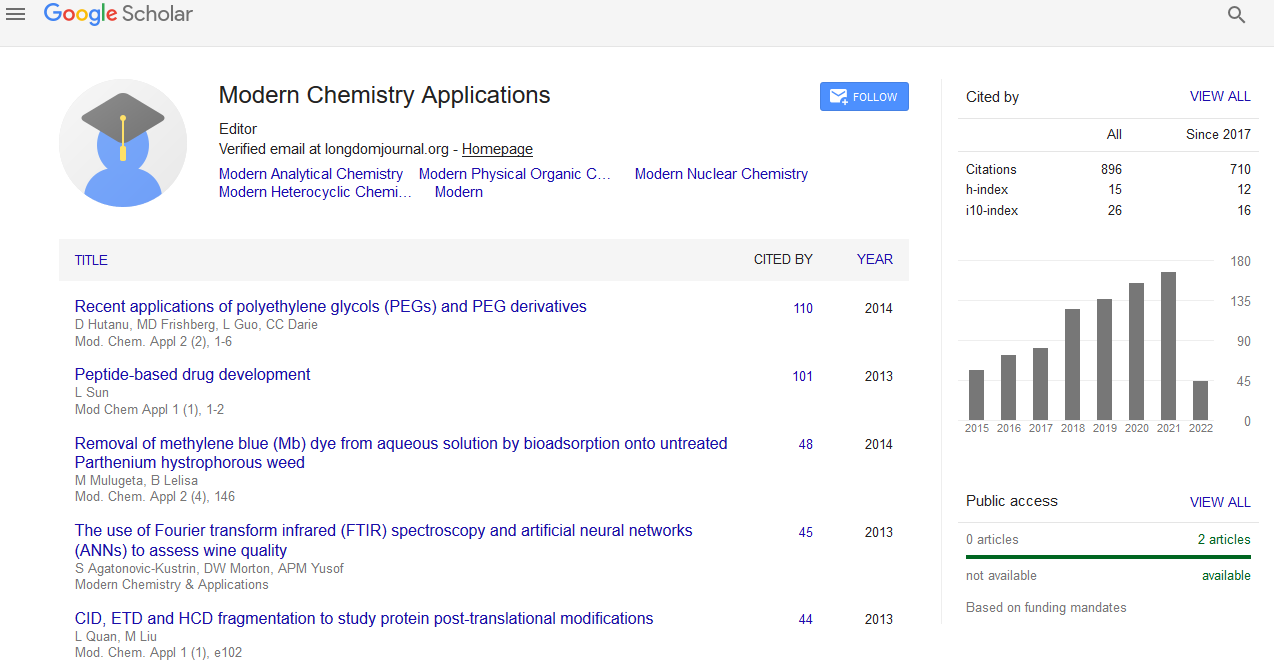Indexed In
- Open J Gate
- JournalTOCs
- RefSeek
- Hamdard University
- EBSCO A-Z
- OCLC- WorldCat
- Scholarsteer
- Publons
- Geneva Foundation for Medical Education and Research
- Google Scholar
Useful Links
Share This Page
Journal Flyer

Open Access Journals
- Agri and Aquaculture
- Biochemistry
- Bioinformatics & Systems Biology
- Business & Management
- Chemistry
- Clinical Sciences
- Engineering
- Food & Nutrition
- General Science
- Genetics & Molecular Biology
- Immunology & Microbiology
- Medical Sciences
- Neuroscience & Psychology
- Nursing & Health Care
- Pharmaceutical Sciences
Abstract
Adsorption of Lambda Cyhalothrin on to Athi River Sediments: Apparent Thermodynamic Properties
Sherrif SS*, Madadi V, Mbugua JK and Kamau GN
Lambda-Cyhalothrin is extensively used in agriculture, horticulture, and public health management in Kenya. The pesticide is effective against many vegetable pests, rice and other disease agents. The adsorption of L-Cyhalothrin onto sediments of Athi River was studied using UV-visible and the results were analyzed by fitting data into isotherm models including Freundlich and Dubinin-Radushvich plot to understand the environmental impacts of this pesticide. The models presented different numerical values but the results demonstrated similar characteristics. The study was aimed at determination of adsorption characteristics of L-Cyhalothrin on sediments from Athi River. Different masses of sediments were spiked with different concentrations of L-Cyhalothrin. The mixtures were shaken at varied times to reach equilibrium. The amounts of pesticide adsorbed were determined by analyzing the difference between the UVvisible Spectrophotometer data and the initial concentrations. Line Plots were used to determine other thermodynamic variables. Various isotherm models were used to explain the adsorption characteristics of the Lambda-Cyhalothrin. It stands out that Dubinin-Radushvich (D-R) with average R2: 0.935, 0.938 and 0.898 fitted best in this experiment while Freudlich R2: 0.783, 0.899 and 0.812 for all sediment samples, Upstream, Midstream, and Downstream, respectively. The spontaneity of the adsorption process was also realized in ΔG (Gibb’s free energy) values as predicted by Freundlich. In both models, Midstream ΔG was negative (-) showing complete spontaneous characteristics. Also in Upstream, ΔG was negative (-) for Freundlich whereas Downstream ΔG was positive (+). Generally, adsorption capacity of Athi river sediments was low due to low mineral contents and total organic Carbon including other physicochemical properties specifically, textures, Nitrogen content including its temperature and moisture contents.


